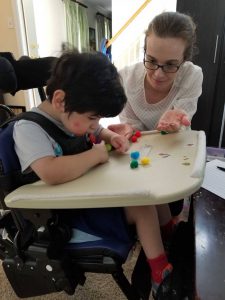 “If you want to see competence, it helps if you look for it.” Douglas Biklen
“If you want to see competence, it helps if you look for it.” Douglas Biklen
In early August I was able to attend the Inclusive Schools Summer Leadership Institute in Syracuse, NY. It was an emerging, thought-provoking conference.
One of the handouts in our folder was this list of Strategies for Presuming Competence. As I read through it I immediately thought of Joey, and how these strategies support the work we do with him, and in turn, allows him to rise academically, socially, and developmentally.
I was struck by the idea of the need to look for competency and evidence of understanding. For children like Joey, it is easy to run through lessons or schedules without taking time to look for evidence of understanding. We wait for the student to meet one set expectation, but don’t always look for other ways a student may show her understanding.
What I think is so powerful about this list is that it gives us permission to look for understanding, instead of leaning towards doubting a child’s ability because they have not proved it in the way we designed a set task.
We are allowed to look. The twitch in the eye? The smile? The glance in the right direction? We can consider these as evidence of understanding. We become the detectives instead of the task masters.
So, what does looking for evidence of understanding look like with Joey?
We always have to remember to follow his eye gaze, even when he is not using his device. He often will gaze-reference something we are talking about in the room. He hears a number? He’ll look toward his calendar. He hears me tell his mom I’ll be back Wednesday, he’ll glance at the calendar. I mention an alligator? Joey will look around his room to where he knows there is a picture of an alligator.
Joey often hits the button next to the right answer on his eye gaze device. Sometimes he’ll follow this up with silly or funny, and other times he’ll go back in to do it again. Still other times he gives up and moves on to the next topic. Yet after watching his pattern I realize he often does know the correct answer, particularly with letters and numbers. He may have a hard time selecting the number 2, and after hitting 3 three times in a row he changes the topic to dinosaurs instead of trying to hit 2 again. But he knows the answer is 2. By realizing this I can shift my focus to helping him strengthen his gaze so he can select the right buttons instead of focusing on counting and identifying the numeral 2.
Every child’s evidence of understanding is going to be different, as every child will show their understanding in different ways. Some will show understanding in different ways on different days, depending on their mood or their energy level. As educators we need to be ready to look.


